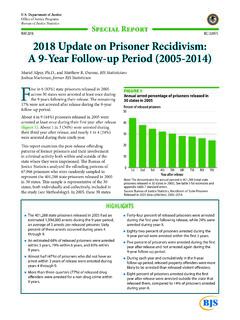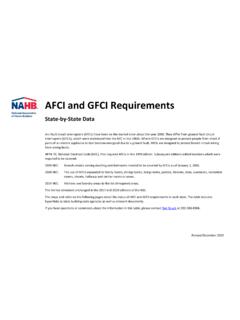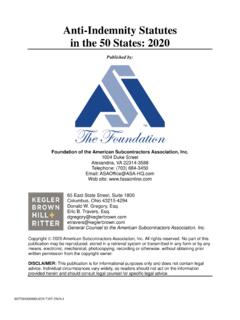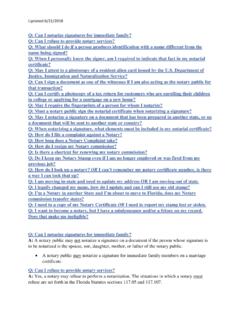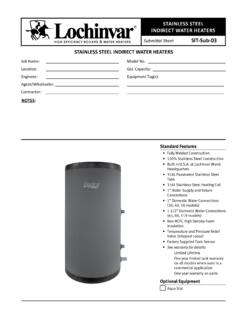Transcription of Truth in Sentencing in State Prisons - Bureau of Justice ...
1 Department of Justice Office of Justice Programs Bureau of Justice Statistics Special Report January 1999, NCJ 170032. Truth in Sentencing in State Prisons By Paula M. Ditton Highlights Doris James Wilson BJS Statisticians Three decades of Sentencing reform & 1970's through 1990's The amount of time offenders serve in Indeterminate Sentencing : Common in the early 1970's, parole boards prison is almost always shorter than the have the authority to release offenders from prison. time they are sentenced to serve by the Determinate Sentencing : States introduced fixed prison terms which could court.
2 Prisoners released in 1996 be reduced by good-time or earned-time credits. served on average 30 months in prison and jail or 44% of their sentence. Many Mandatory minimum sentences: States added statutes requiring offenders States have recently enacted a Truth -in- to be sentenced to a specified amount of prison time. Sentencing law which requires offend- Sentencing guidelines: States established Sentencing commissions and ers to serve a substantial portion of created ranges of sentences for given offenses and offender characteristics.
3 Their sentence and reduces the discrep- ancy between the sentence imposed Truth in Sentencing : First enacted in 1984, TIS laws require offenders and actual time served in prison. to serve a substantial portion of their prison sentence. Parole eligibility and good-time credits are restricted or eliminated. In the early 1970's States followed an Discrepancy between sentence Violent offenders released from indeterminate Sentencing model in and time served prison in 1996 were sentenced to which a parole board decided when an serve an average of 85 months in offender would be released from State Prisons , 1996 prison.
4 Prior to release they served prison. Pressure for longer sentences First releases 62 mo about half of their prison sentence and uniform punishment led to manda- All sentence or 45 months. tory minimums and Sentencing guide- offenders 30 mo time served lines in the 1980's. However, prison 85 mo Under Truth -in- Sentencing laws crowding, good-time sentence reduc- Violent offenders requiring 85% of the sentence, violent tions for satisfactory prison behavior, 45 mo offenders would serve an average and earned-time resulted in the early New admissions of 88 months in prison based on the release of prisoners.
5 104 mo Violent sentence average sentence for violent offenders offenders 88 mo admitted to prison in 1996. To assure that offenders serve a large time to serve 85%. portion of their sentence, the Nearly 7 in 10 State prison admis- Congress authorized funding for Admissions of violent offenders to State Prisons sions for a violent offense in 1997. additional State Prisons and jails were in States requiring offenders to through the Violent Crime Control and 80,000 serve at least 85% of their sentence. Law Enforcement Act of 1994.
6 In 1998 All States incentive grants were awarded to 27 60,000 By 1998, 27 States and the District States and the District of Columbia that of Columbia met the Federal Truth -in- met the eligibility criteria for the Truth - 40,000 Sentencing Incentive Grant Program in- Sentencing program. Another 13 Truth -in- Sentencing eligibility criteria. Eleven States States have adopted a Truth -in- 20,000 States requiring adopted Truth -in- Sentencing laws in Sentencing law requiring certain offend- 85% of sentence 1995, 1 year after the 1994 Crime Act.
7 Ers to serve a specific percent of their 0. sentence. 1993 1994 1995 1996 1997. Data were compiled from multiple Table 1. Truth -in- Sentencing requirements, by State sources 50% 100% of minimum Other Meet Federal 85% requirement requirement requirement requirements The findings in this report are based primarily on data from the Bureau of Arizona Missouri Indiana Idaho Alaskac California New Jersey Maryland Nevada Arkansasd Justice Statistics, National Corrections Connecticut New York Nebraska New Hampshire Coloradoe Reporting Program (NCRP)
8 , and data Delaware North Carolina Texas Kentuckyf collected through the Violent Offender District of Col. North Dakota Massachusettsg Incarceration and Truth -in- Sentencing Florida Ohio Wisconsinh Georgia Oklahomab (VOI/TIS) Incentive Grants program, Illinoisa Oregon administered by the Office of Justice Iowa Pennsylvania Programs Corrections Program Office. Kansas South Carolina Louisiana Tennessee Maine Utah Since 1983 BJS has compiled the Michigan Virginia NCRP data series that collects individ- Minnesota Washington ual inmate records for prison admis- Mississippi sions and releases and parole a Qualified for Federal funding in 1996 only.
9 Convictions serve 75%; 1 prior violent con- discharges. It is the only national level b Effective July 1, 1999, offenders will be viction, data base with information on sentence required to serve 85% of the sentence. f Effective July 15, 1998, offenders are required c Two-part sentence structure (2/3 in prison; to serve 85% of the sentence. length, time to be served in prison, 1/3 on parole); 100% of prison term required. g Requires 75% of a minimum prison sentence. d actual time served by released prison- Mandatory 70% of sentence for certain h Effective December 31, 1999, two-part ers, time served on parole, type of violent offenses and manufacture of metham- sentence: offenders serve 100% of the prison phetamine.
10 Parole discharge, and offense composi- e term and a sentence of extended supervision Violent offenders with 2 prior violent at 25% of the prison sentence. tion of inmates entering and exiting prison and parole. The annual series Sentencing reforms parallel get Such discretion in Sentencing and includes prison population movement release policies led to criticism that tough on crime attitude data and parole population data, some offenders were punished more providing a comprehensive description harshly than others for similar offenses Sentencing reform policies have paral- of offenders as they enter and exit and to complaints that overall sentenc- leled the mood of the country on crime correctional custody and supervision.




